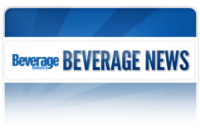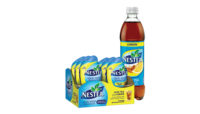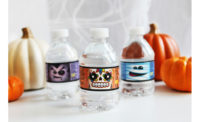With a career spanning 35 years in the bottled water business, Kim Jeffery has seen a drastic change within the beverage industry since he joined Perrier Group of America in 1978. At that time, the U.S. water category primarily consisted of 5-gallon containers and was a $250 million business, he says. Although the company’s flagship Perrier sparkling water brand was available overseas for nearly a century prior to its debut in the United States, much of the U.S. beverage industry did not believe that Americans would pay $0.79 for a bottle of water, he adds. Jeffery and his team, however, thought otherwise and set out to prove them wrong.
| Jump to: |
Shortly after Perrier’s U.S. launch, the brand became “an instant success” in the marketplace, notes Michael Bellas, chairman and chief executive officer of Beverage Marketing Corp., New York. In fact, the brand even inspired more than 40 works of art by Andy Warhol in the ‘80s, which the company is paying tribute to now via a series of limited-edition bottles.
“[Perrier] was an alternative to both traditional non-alcoholic beverages, like [carbonated soft drinks], and it became in social settings almost a replacement for somebody that didn’t want to drink an alcoholic beverage but still wanted to have sophistication and something that would be appropriate in a cocktail setting,” Bellas explains. “It was a very, very big success.”
Today, Perrier Group of America, now known as Nestlé Waters North America (NWNA), Stamford, Conn., is the largest bottled water company in the United States with volume share of nearly 32 percent and revenue share of almost 36 percent, according to Beverage Marketing Corp. To put that into perspective, NWNA’s volume share of the market is approximately double that of its closest competitor, Bellas says. Comprising 12 bottled water brands across all of the category’s segments — single-serve, sparkling, imports, bulk and home-and-office delivery — as well as three tea brands across multiple price points, the company has grown from $20 million in sales in 1978 to more than $4.2 billion in sales last year.
By comparison, the entire bottled water category reached nearly $12 billion last year, and volume reached a historical high of almost 9.7 billion gallons, which represents the category’s strongest growth in five years, Beverage Marketing Corp. reported in its “Bottled Water in the U.S.” analysis.
This year, NWNA expects to continue its growth but under new leadership. In February, Jeffery stepped down from his 20-year role as president and chief executive officer of NWNA and assumed a non-executive chairman position prior to his retirement in February 2014. During his tenure as president and chief executive officer with the company, sales increased sevenfold, which is a significant accomplishment, Beverage Marketing Corp.’s Bellas notes. Although Jeffery left some pretty big shoes to fill, his replacement is more than qualified to take the reins.
After joining NWNA 25 years ago and spending three years as the president and chief executive officer of Nestlé Canada, Tim Brown took over as the president and chief executive officer of NWNA in February. Prior to joining Nestlé Canada, Brown was executive vice president of retail operations for NWNA, where he worked closely with Jeffery to help position the company as the No. 1 bottled water company in North America.
“I am excited to continue to build on the legacy achieved by Kim Jeffery,” Brown said in a statement. “Kim led the company from a single brand to the largest bottled water company in North America, while emphasizing environmental responsibility and cultivating the very best corporate culture in the food and beverage business.”
As long-time friends and co-workers, Brown and Jeffery share a vision for the industry that Brown plans to continue as the company’s new leader.
Rising to the top
One such legacy that Brown will continue to encourage is healthy hydration. As a result, he and Jeffery expect bottled water to eclipse the carbonated soft drinks (CSDs) category and take over as the No. 1 beverage category in the United States within five years.
“It’s a question of when, not if,” Jeffery says. “It’s going to happen.” In fact, bottled water already outsells CSDs in 15 U.S. grocery markets, he says.
The company’s fastest-selling brand is Nestlé Pure Life, Brown says. Because there is such a growing demand within the U.S. market for portable, accessible, high-quality water, he expects the brand to double its sales within 10 years. Already, it is the No. 1 single-serve brand based on volume, Beverage Marketing Corp.’s Bellas affirms.
One of the primary factors leading to the rise of bottled water is consumers’ increasing interest in health and wellness, Brown says.
Considering the high obesity rate of U.S. consumers and governmental attempts to tackle this issue, such as New York Mayor Michael Bloomberg’s proposed ban on soft drinks larger than 16 ounces, bottled water is easily accessible as a healthy solution — and consumers seem to have noticed.
“Consumers are smart; they realize [water] is the best they can put in their body, so they’re doing it at a greater frequency,” Brown says. “They’re inherently drinking less of other beverages and more water, so that’s driving the category growth.”
This runs parallel with the Partnership for a Healthier America’s new Drink Up initiative, of which NWNA is a supporter (see page 34), in addition to NWNA’s many other partnerships and campaigns to promote healthy hydration.
Plastic pioneers
In addition to delivering a healthy, hydrating product portfolio, NWNA realized the importance of convenience for consumers and released its first PET bottle in 1989, which revolutionized the industry, Jeffery says. At that time, CSDs were so dominant that it was challenging to find a bottle manufacturer that would step outside of that category, he explains. After struggling with this issue for a few years, NWNA realized it would need to make its own bottles in order to compete. Therefore, in 1994, it began manufacturing its own preforms and blowing its own bottles. Doing so enabled the company to lower costs, improve bottle quality and benefit the environment, Brown says.
Becoming a vertically integrated company also enabled it to capitalize on one of the most versatile beverage categories in existence.
“In 1992, single-serve waters were really not on the map,” Beverage Marketing Corp.’s Bellas says. “[NWNA was] one of the first ones to realize the potential for single-serve waters. It was the perfect product for the consumer looking for something good for you. It was dietetic, it was all natural, it didn’t have to be chilled … and it had more usage occasions than any other product we’ve ever seen. … Plus, it has this wonderful good-for-you halo.”
Although putting its waters in single-serve PET bottles opened up numerous new consumption opportunities for consumers, NWNA didn’t stop there. Currently, NWNA’s Resource, Arrowhead and Deer Park brands are packaged in bottles made from 50 percent recycled PET (rPET). And, within the next year, NWNA plans to open another facility for making rPET, which will enable at least one more brand to be packaged in 50 percent rPET, Jeffery says. Within five years, the company aims to have some amount of recycled material in all of its packaging, Brown adds.
“We think that recycled plastic material is going to be a very important source of material in the future,” Brown says. “There’s a finite amount of resources in the world, so why not use the ones that are available to be used over again, hence recycling?”
“We think that recycled plastic material is going to be a very important source of material in the future." |
However, the stream of rPET is limited by the amount of bottles that consumers recycle, Jeffery explains. Therefore, he introduced the concept of Extended Producer Responsibility for consumer packaging, which brings the financial responsibility of recycling to the industry and works to increase consumers’ access to curbside recycling and away-from-home recycling for bottles and all other product packaging.
“If you look across the country, the average collection of solid waste that’s recyclable is 34 percent, and it’s not moving anywhere,” he says. “I believe that in order for us to get rates of recycling up — that includes all types of plastic, all types of corrugate, aluminum, everything that can be recycled and reused again — I believe that industry’s going to have to be part of the solution, and that’s where the idea of Extended Producer Responsibility comes in.”
Offering three of its brands in 50 percent rPET helps NWNA to showcase its devotion to recycling.
“Part of our mission is to show people that if you recycle it, we’ll use it again,” Jeffery says. “Interestingly, bottled water recycling rates are now up almost to 40 percent, where the rest of the beverage industry for PET is still around 30 [percent]. So just in the last two years, we feel like we’ve moved the needle.” NWNA aims to increase the plastic bottle recycling rate even further to 60 percent by 2018.
Although not all of the company’s bottles include recycled content, they have undertaken their own strategies for being friendlier to the environment throughout the years. According to Jeffery, NWNA pioneered what is known today as “lightweighting” more than 15 years ago but only made dramatic reductions of the plastic in the last 10 years.
“Starting in the late 1990s, every time we put in a new line and bought new bottle-blowing equipment, we kept trying to push how much lighter the bottle could go and how we could make it a better bottle,” Brown explains. “It wasn’t really until 2007 that we publicized that we’d been working on lighter bottles.”
That year, NWNA released its next-generation half-liter Eco-Shape bottle, which uses an average of 60 percent less plastic than its original half-liter PET bottle.
“It was a quantum leap in light-weighting and, in fact, so much so that consumers really didn’t like it right away,” Jeffery says. Consumers associated a thinner bottle with flimsiness instead of sustainability, so the company had to help them understand why the reduction of plastic was good, he explains.
Besides the thickness of the bottle, its shape and size is another way that the company keeps up with consumer desires, such as portion packaging for kids and sports closures for exercising or competing in sports. For instance, NWNA offers 8-ounce bottles of its Nestlé Pure Life water for children and 11-ounce Aquapod bottles of its regional spring water brands for preteens. The bottles also enable kids to write their names on the label so that they know which bottle is theirs, Brown notes. The company also offers 700-ml bottles with sport tops for active adults who are looking for a more convenient way to hydrate, he says.
Tea time
Further building upon its health and wellness platform, NWNA took on a new role in the ready-to-drink (RTD) tea category in 2011 by acquiring the Sweet Leaf Tea Co., which makes organic, all-natural, home-style iced teas, lemonades and other natural beverages.
“We saw tea as an emerging category that had really positive attributes toward health and wellness,” Brown says.
NWNA originally made a $15.6 million investment in the tea company in 2009. The following year, the Sweet Leaf Tea Co. acquired Tradewinds Beverage Co., which makes all-natural, kettle-brewed iced teas and juices. NWNA fully acquired the Sweet Leaf Tea Co. in 2011.
Most recently, the Nestea brand came under the company’s umbrella after the Beverage Partners Worldwide joint venture between The Coca-Cola Co., Atlanta, and Nestlé dissolved. Throughout the 20-year partnership, Nestea was distributed using the Coca-Cola bottling system. Now, NWNA will be responsible for distributing Nestea in the United States, Brown explains.
Since the transition, the company has enhanced the Nestea brand in a few ways. In September, NWNA took its first step into the U.S. liquid concentrates segment by introducing Nestea Liquid Water Enhancers made from real tea leaves.
“There’s a big race to get into these concentrated drops by all kinds of manufacturers,” Brown says. “We think this really stands out as the clear and only tea option.”
The RTD Nestea teas also got a formulation makeover, enabling the company to reduce the amount of sugar in the product but improve the taste, he says.
“It’s a real priority to get our new formulas out there, because we believe it’s significantly better than what’s been sold in the past on Nestea,” Brown says.
Because the tea category mirrors the bottled water category in many ways, it is a natural fit for NWNA.
“We see tea as a diverse category, just like water,” Brown says. Preferences for pricing, packaging, type of tea and flavor profile all vary among consumers, he explains.
“Some tea consumers want it sweet, and some tea consumers would prefer it not to be sweet; some like to drink it out of a can, and some like to drink it out of a plastic bottle,” he says. “What you’ll see in this diverse category is brands have taken on a role to meet certain consumer groups, and we’re going to need a stable of brands to be able to do that, so [Sweet Leaf, Tradewinds and Nestea] have different roles in our stable.”
Sweet Leaf, for instance, is a high-end, super-premium, more whimsical brand that features organic ingredients. It is sold mostly in glass bottles and competes with products that are aimed at health enthusiasts who are particularly concerned about the ingredients in the products they consume, Brown explains. Tradewinds also is a premium brand but targets tea purists, because it has a strong tea taste and a slow-brewed positioning, he adds.
Nestea, on the other hand, offers a more mainstream taste profile. “We see Nestea as popular brand meets the popular palate of sweetness meets the popular package types and price points,” Brown says.
With roots planted firmly in the tea category and growth on-track to place bottled water in the No. 1 spot within the beverage industry, NWNA has a transformational few years ahead.
Water by geography
Building off the success of its Perrier sparkling water, Nestlé Waters North America’s (NWNA) next step was to expand nationally by acquiring regional spring water brands across the country. This way, NWNA caters to consumers within specific regions of the United States by offering them a familiar flavor profile and local source of water that they can related to, says Tim Brown, president and chief executive officer of NWNA. For instance, Poland Spring natural spring water is sourced from springs in Maine and is available throughout New England and the Northeast. It is particularly light in minerals, which is consistent with the type of water people grew up drinking in that region, he explains. Likewise, Zephyrhills natural spring water contains a higher amount of minerals, which is consistent with the kind of water people grew up drinking in the Florida region, he adds.
“What we did is we put together a system of brands that could act like one for national retailers, but they’re all relevant locally to the people who live in those geographies, and they all come from a specific place and have spring water characteristics that people in that part of the country are familiar with,” Brown explains.
The regional waters also help to simplify distribution and reduce costs because they enable the company to transport the waters within a shorter distance rather than carry full bottles of water across the country, he points out.







